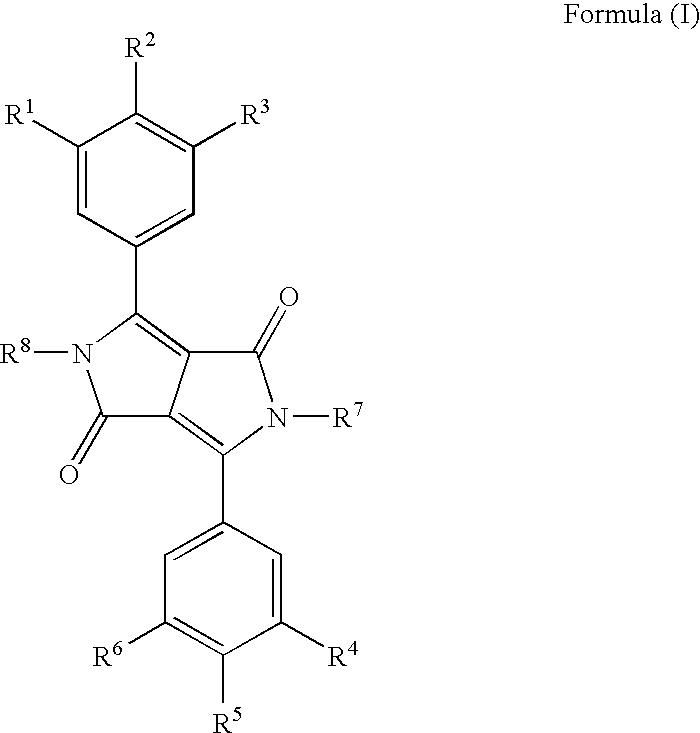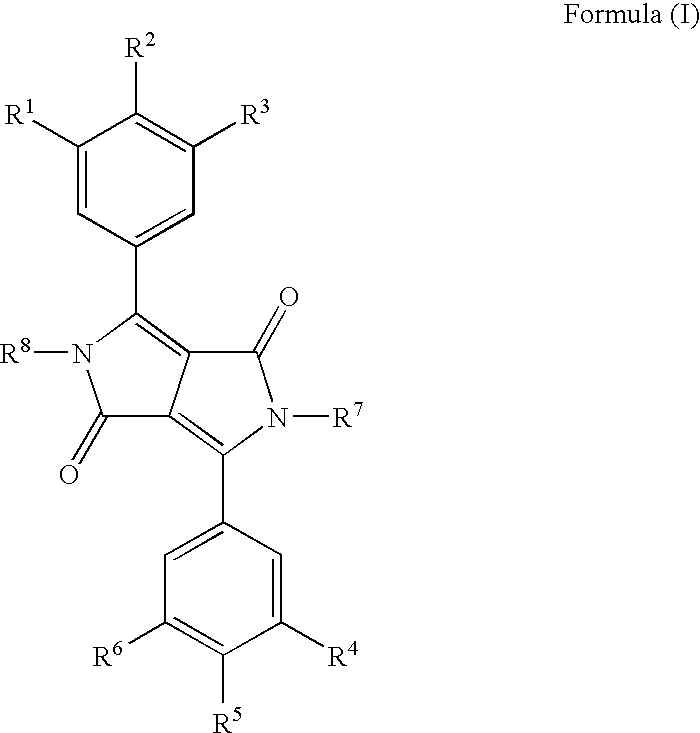Diketopyrrolo-Pyrrole Compounds
a technology of pyrrolopyrrole and compound, which is applied in the field of pyrrolopyrrole compounds, can solve the problems of pigments that are particularly difficult to disperse, the preparation of good thermally stable dispersions with submicron particles is more difficult for non-aqueous inkjet inks, and pigments may have a tendency to re-agglomerate, etc., and achieves high image quality, high dispersion quality and stability, the effect of high optical density
- Summary
- Abstract
- Description
- Claims
- Application Information
AI Technical Summary
Benefits of technology
Problems solved by technology
Method used
Image
Examples
example 1
[0259]This example illustrates that stable non-aqueous C.I. Pigment Red 254 inkjet inks with high dispersion quality for producing high image quality images were obtained when using a diketopyrrolo-pyrrole derivative in accordance with a preferred embodiment of the present invention.
Dispersion Synergists
[0260]The compounds DPS-1 to DPS-3 of Table 4 were used as dispersion synergist to prepare comparative pigment dispersions.
TABLE 4DPS-1DPS-2DPS-3
Dispersion Synergist DPS-1
[0261]Synthesis of the dispersion synergist DPS-1 was accomplished according to the following synthesis scheme:
35.7 g (0.1 mol) of the pigment PR254 in 210 mL dimethylsulfoxide was heated to about 80° C. The magenta suspension was dissolved by addition of 22.44 g (0.2 mol) of potassium tert-butoxide (acros). 13.6 g (0.1 mol) of 1,4-butanesultone and 1.7 g (0.01 mol) of potassium jodide were added to the solution and the mixture was heated for 6 hours. After cooling down to room temperature the dispersion synergist D...
example 2
[0270]This example illustrates the synthesis of dispersion synergists derived from the pigments C.I. Pigment Orange 71, C.I. Pigment Orange 73 and C.I. Pigment Red 264.
Dispersion Synergist DPC-7
[0271]Synthesis of the dispersion synergist DPC-7 was accomplished according to the following synthesis scheme:
44.0 g (0.1 mol) of PR264 (=C.I. Pigment Red 264) in 500 mL dimethylsulfoxide was dissolved by the addition of 22.44 g (0.2 mol) potassium tert-butoxide. The solution was heated to about 70° C. and 27.1 g (0.1 mol) of compound DP-1 was added. The alkylation-step was completed after 4 hours and the mixture was cooled to 50° C. 500 mL of methanol was added and the unreacted starting product was filtered off. Hydrolyzation was started with the addition of 60 mL (0.6 mol) of a 29% sodium hydroxide solution to the filtrate. The solution was heated to 55° C. and after 30 minutes it was cooled to room temperature. 57.2 mL (1 mol) of acetic acid was added and the synergist was precipitated w...
example 3
[0274]This example illustrates that stable non-aqueous C.I. Pigment Orange 71 inkjet inks with high dispersion quality for producing high image quality images were obtained when using a diketopyrrolo-pyrrole derivative containing two carboxyl groups.
Preparation and Evaluation of Inkjet Inks
[0275]Inkjet inks were prepared in exactly the same manner as in Example 1 except that the pigment P071 was used instead of PR254 in combination with different dispersion synergists.
[0276]The comparative inkjet inks COMP-6 and COMP-7 and the inventive inkjet inks INV-3 and INV-4 were prepared according to Table 7. The spectral separation factor SSF and the particle size were determined to evaluate the dispersion quality. The dispersion stability was evaluated by determining the spectral separation factor SSF and the particle size again after a heat treatment of 7 days at 80° C. The results are listed in Table 7.
TABLE 7Before heat treatmentAfter 7 days at 80° C.InkjetDispersionParticleLoss inPartic...
PUM
| Property | Measurement | Unit |
|---|---|---|
| Fraction | aaaaa | aaaaa |
| Fraction | aaaaa | aaaaa |
| Fraction | aaaaa | aaaaa |
Abstract
Description
Claims
Application Information
 Login to View More
Login to View More - R&D
- Intellectual Property
- Life Sciences
- Materials
- Tech Scout
- Unparalleled Data Quality
- Higher Quality Content
- 60% Fewer Hallucinations
Browse by: Latest US Patents, China's latest patents, Technical Efficacy Thesaurus, Application Domain, Technology Topic, Popular Technical Reports.
© 2025 PatSnap. All rights reserved.Legal|Privacy policy|Modern Slavery Act Transparency Statement|Sitemap|About US| Contact US: help@patsnap.com



